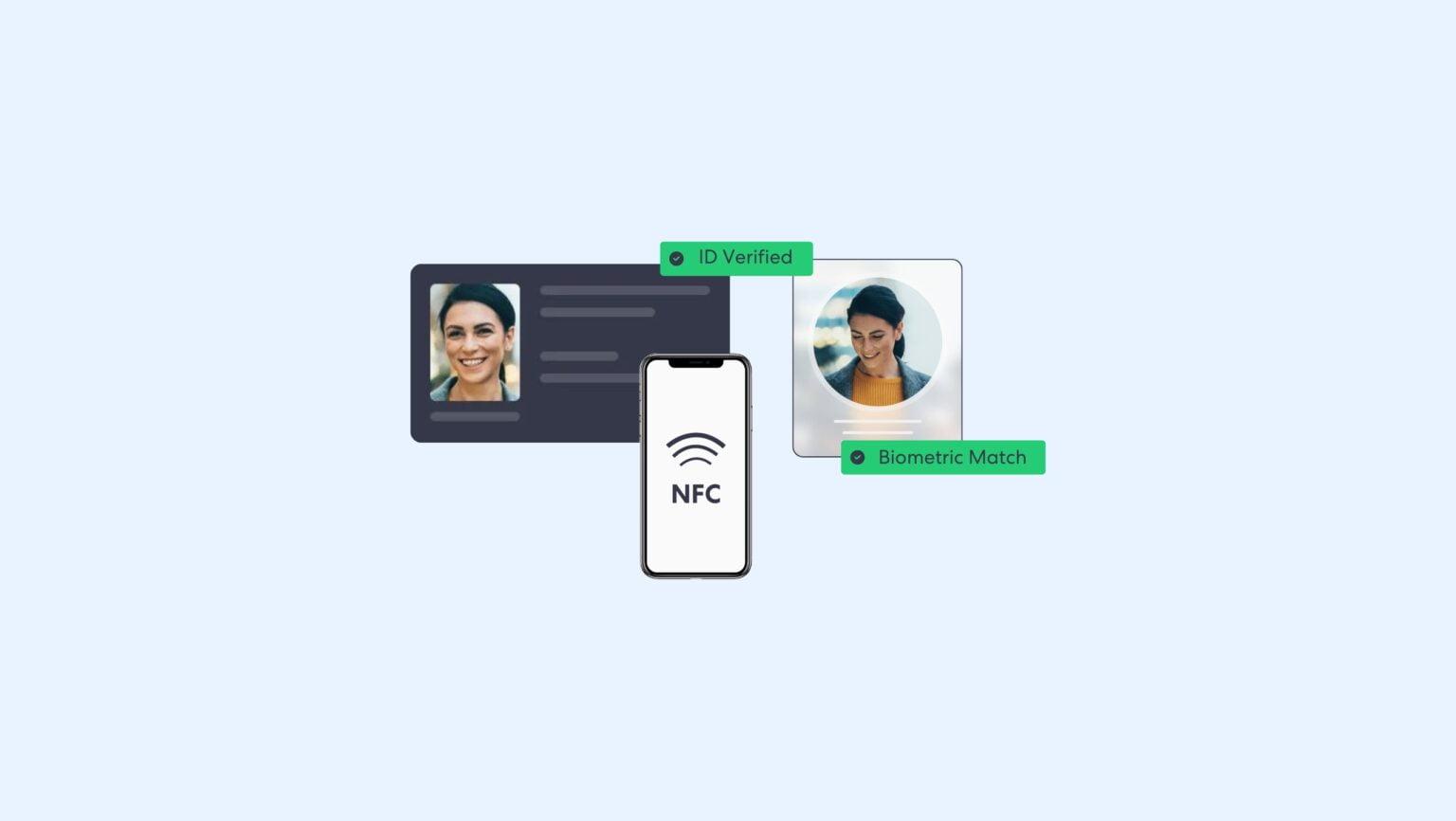Near-field communication (NFC) technology allows secure wireless data transfers between two devices without the need for WiFi. NFC identification has become a more secure method used in the modern Identity Verification process. But what is NFC ID verification? This guide explains what an NFC tag is and how it is used in the document verification process.
What is NFC Technology?
Near-field communication (NFC) is a technology used to wirelessly connect devices over short distances. Conducted over a range of no more than a couple of inches, NFC enables seamless data transfer to the highest available precision.
If readers aren’t familiar with the name, they will certainly be familiar with the concept. NFC is the technology that powers everyday transactions via Apple Pay, Google Pay, contactless payment cards, and many other scanning events in multiple industries.
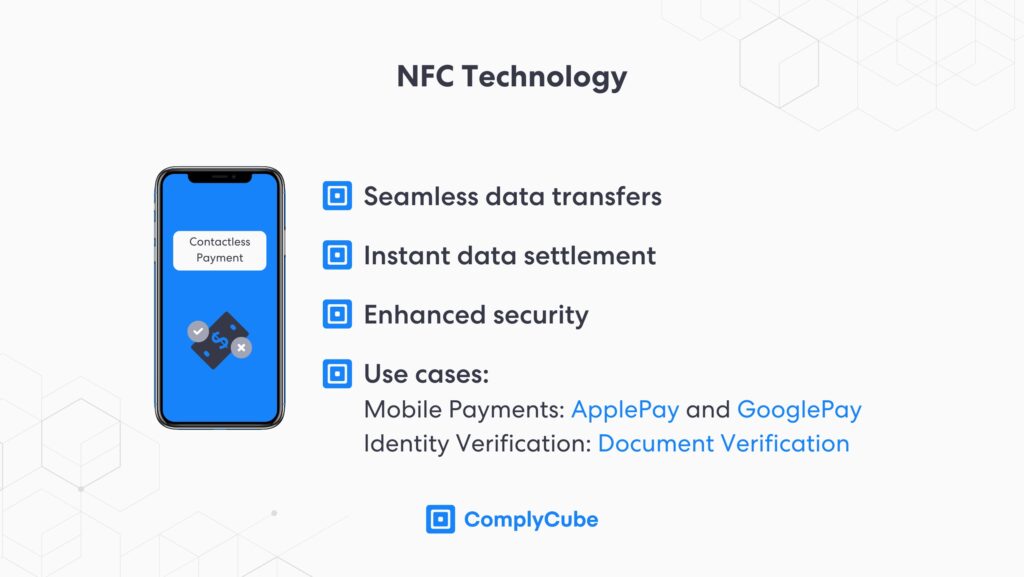
RFID Chips
Previously, wireless data was transferred via a Radio Frequency Identification (RFID) chip, a technology that enabled information sharing and reading via radio waves. These radio waves are transmitted via wave propagation and can travel without fading for extremely large distances.
NFC chips, however, use a different frequency of waves to create an environment for short-range data sharing. It transmits data via magnetic field induction, corresponding to a wavelength of 22 meters, with a frequency of 13.56MHz.
This means that NFC waves fade out far quicker than radio waves, making them far more secure. During an NFC data transfer, the proximity at which any device must be in of the event is a couple of inches, making attempts at data compromization futile.
Another crucial innovation behind NFC technology is the inherent security through cryptography. NFC chips are encrypted, meaning that the only way the data can be ‘viewed’ is when NFC-enabled devices cryptographically verify it.
How NFC-Based Identity Verification Works
Document verification is the verification of government-issued electronic identity documents, including biometric national identity cards such as passports and driver’s licenses. Modern verification methods use advanced verification systems to verify and validate client information through an uploaded image.
NFC identity document verification adds an additional layer of security to identity verification. The technology ensures secure data transfer from a document to an enabled device in seconds, providing a frictionless onboarding process while maximizing security.
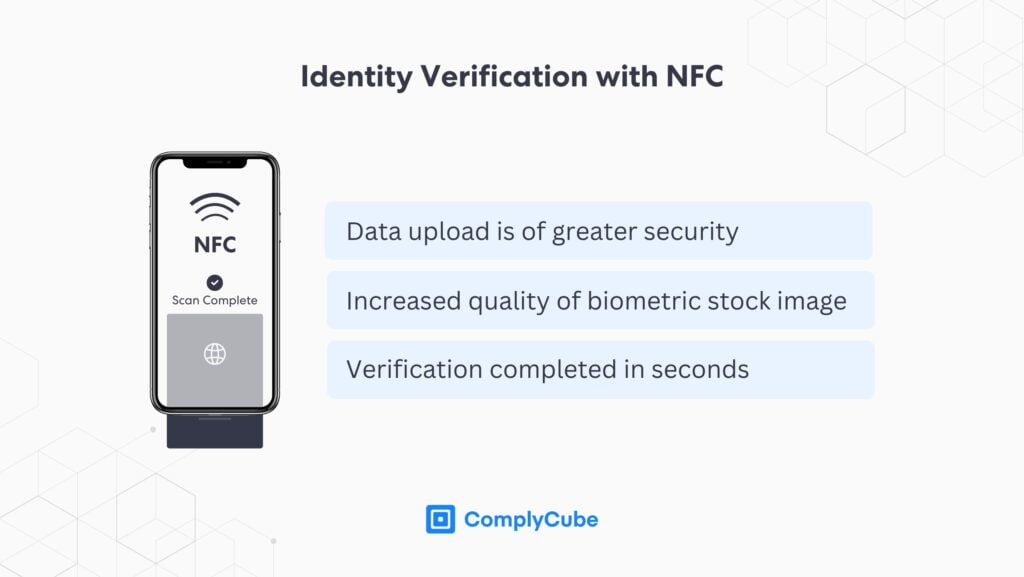
Data Extraction in NFC ID Verification
The NFC identity verification flow involves two processes: the data extraction process and the cryptographic validation stage. Once a user places an NFC document near an enabled device, the 4-step NFC verification begins.
Secure Data Access
There are two methods that are used to initiate an NFC verification, Basic Access Control (BAC) and Password Authenticated Connection Establishment (PACE).
- BAC is used to verify passports: 3 data points, including the official document number, date of birth, and expiration date, are analyzed from the Machine Readable Zone (MRZ). Together, these create a session key that decrypts the data on the NFC chip and allows secure identity verification to begin.
- PACE is a slightly different method used for national ID cards. A 6-digit code on the front of the document is scanned to create a secure connection with the NFC chip for clients to be processed.
Once the connection is established, the reader can extract the data from the NFC chip. This includes the information on the ID document as well as a high-resolution biometric stock image of the individual.
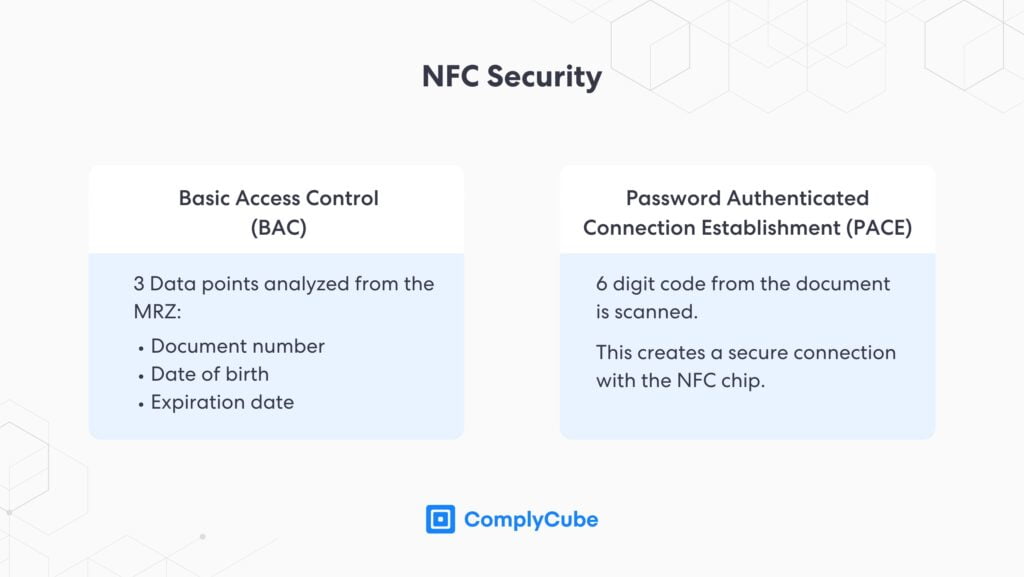
Cryptographic Verification with NFC Technology
The verification process starts with passive authentication and ensures that the chip has not been tampered with since its issuance. Each data element is cryptographically verified using the private key.
Following this, the NFC chip undergoes active authentication, which sends the NFC chip a challenge-response test. Assuming the chip is genuine and not a replica, it will generate a response with its private key to verify its authenticity.
Biometric Matching
When a high Level of Assurance (LoA) is required, IDV must involve a biometric verification step. Biometric verification involves a user taking a live selfie or video for even stronger results, which is analyzed for liveness, and tampering along with many other compliance specifications. The supplied image or video is compared with the stock photo from the ID document for similarities. For more information on biometric verification, read the Advantages of Biometric Authentication.
When NFC based ID verification is used, the stock image uploaded to the NFC-enabled device is of superior quality to when a document is captured via a smartphone. This means that the verification engine can perform a more consistent and reliable analysis between the two.
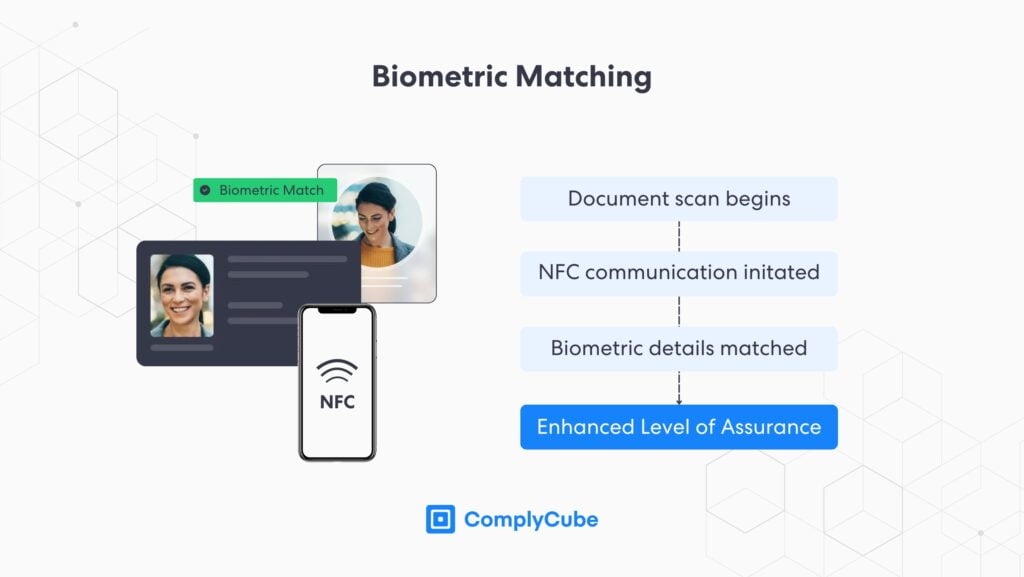
Benefits of Using NFC ID Verification
An NFC verification process strengthens a company’s IDV tech stack without reducing the User Experience (UX). Enhancing the UX is a fundamental practice in modern-day client acquisition processes and is one of the leading factors behind customer churn.
Frictionless UX
Near-field communication technology can transmit data in seconds between NFC-enabled biometric passports or ID cards and NFC-enabled smartphones. NFC-based verification allows new customers to sign up with contactless technology, contributing to an institution or company’s commitment to customer excellence.
A 2024 report found that the median churn rate in the financial services industry was 19%, a direct consequence of poor customer experience (UX). Traditional Financial Institutions (FIs) have been disrupted over the past few years primarily due to the gap in customer understanding. Neobanks have been leading this disruption.
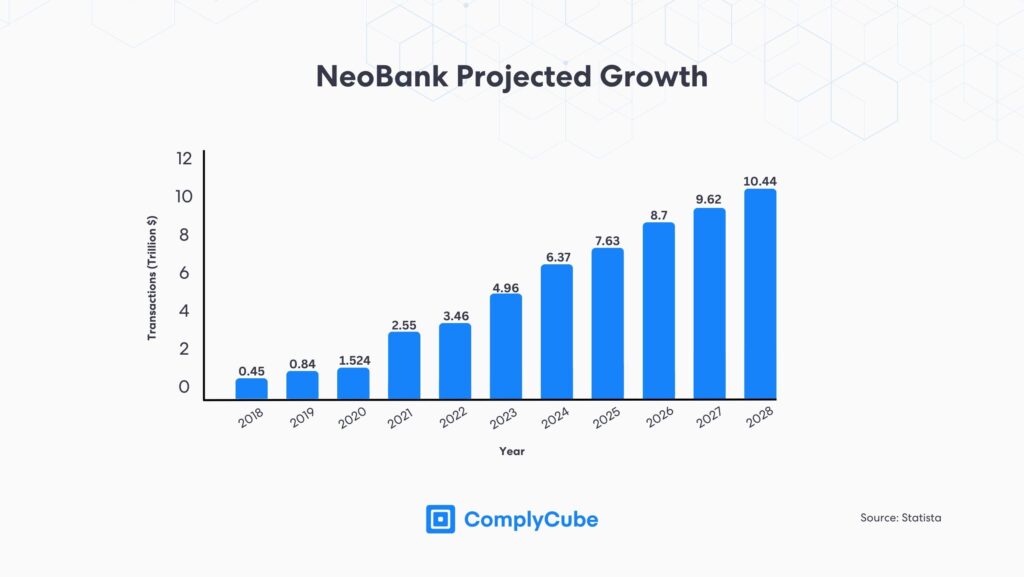
However, it is not only neobank but all modern financial services, including payment solutions and crypto exchanges, that now leverage sophisticated compliance solutions, such as NFC ID verification. The adoption of NFC and automated technology has allowed neobank and crypto exchanges to grow their user base astronomically over the past 5 years.
Deter Fraudsters
NFC verification makes it extremely challenging to create forged documents that can bypass NFC readers, making it much harder to commit identity fraud. The biometric data stored on the NFC chip can only be decrypted under specific scenarios. This not only makes the concept of forgery much more difficult but significantly reduces the risk-reward for bad actors and criminals who might be tempted.
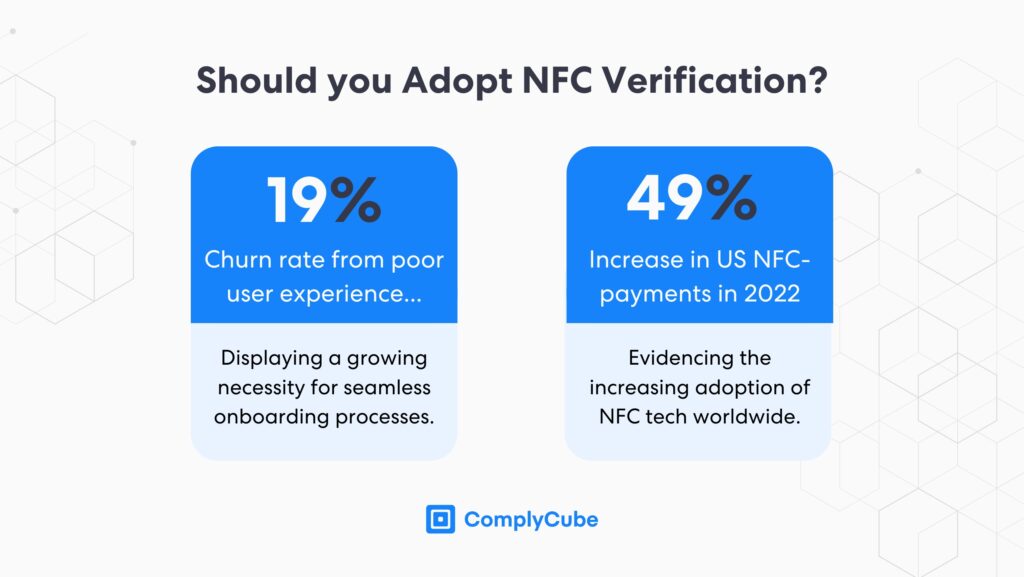
NFC ID Security
Identity documents that are verified via NFC are far less likely to be compromised. The system shares information over a fraction of the distance that traditional methodologies do, meaning identity documents remain secure.
This is a contributing reason why NFC technology is so well adopted in contactless payments. In 2022, US mobile payments increased from 29% to 43.2%, displaying a growth of 49% in the sector.
American contactless mobile payments grew by 49% in 2022.
Compliance solutions are designed to maximize security but shouldn’t make businesses choose between security and customer experience. Adopting NFC technology enables institutions to maximize security while prioritizing UX.
About ComplyCube
ComplyCube is an award-winning SaaS compliance platform that provides solutions to empower FIs, crypto platforms, telecom firms, and many others with regulatory adherence. Boasting an intuitive, all-in-one dashboard, firms can take total control over the IDV process by setting personalized risk scenarios according to their unique Risk-Based Approach (RBA).
The firm provides a suite of Anti-Money Laundering (AML) and Know-Your-Customer (KYC) solutions in addition to its IDV services, making it a one-stop shop for modern compliance. For further queries about NFC ID verification or AML solutions, start a conversation with a specialist today.
